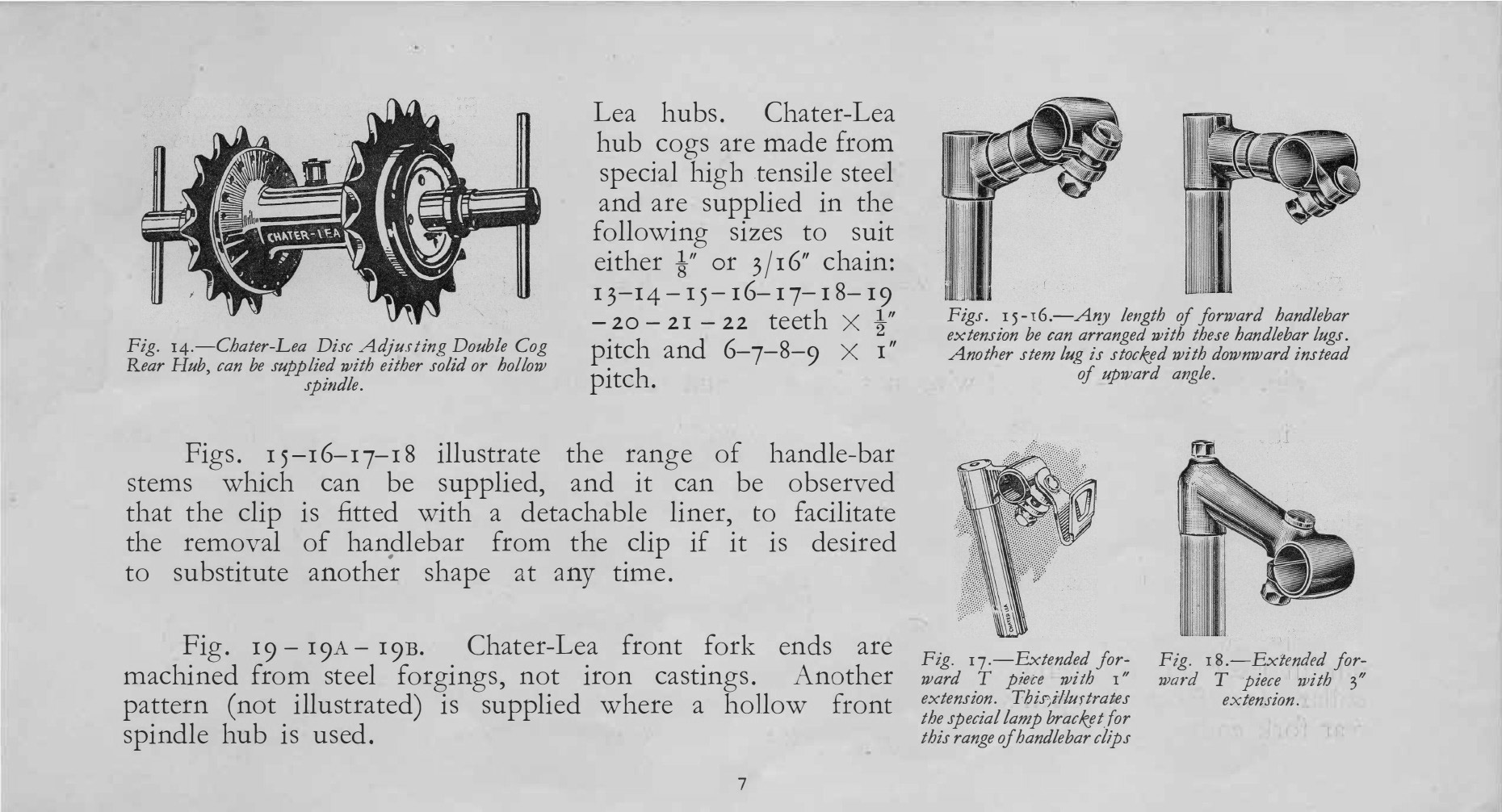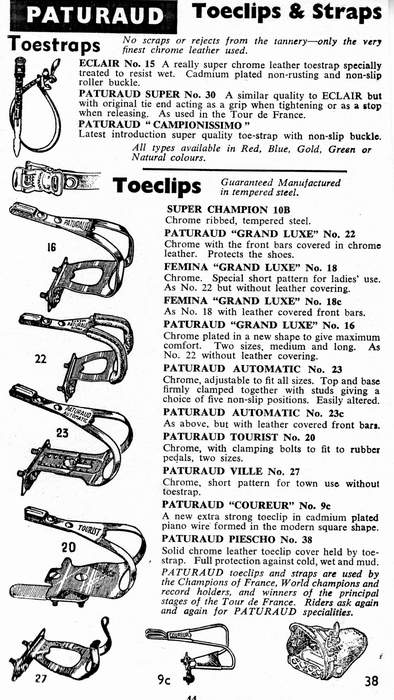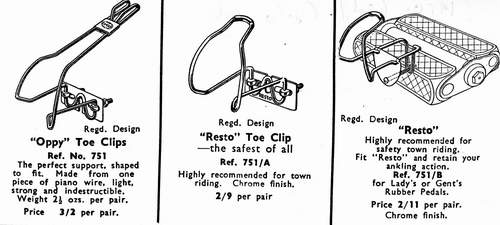Toeclips
Posted: Tuesday 16th June 2020
Cycling trivia pursuit question: which lightweight component never satisfactorily made the transfer from steel to alloy construction?
Answer: Toeclips, although I would also accept saddle frames (as Brooks found out in the 50’s).
Toeclips: one of the most effective aids to more efficient cycling. Also a safety aid preventing the foot slipping. At the same time one of the least understood components by non- and occasional- cyclists (“I wouldn’t use those, be frightened of getting my feet stuck” is a commonly heard comment).
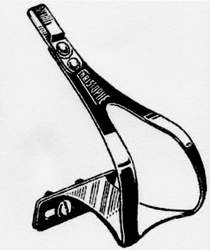
The sprung chromed steel clip (sometimes on copper), of which the Christophe (image right) was the most widely used, reigned supreme from the early 1930’s until the 1990’s with the move to clipless pedals. Named after the French rider, Eugene Christophe, who is probably the most famous Tour de France rider never to have actually won the Tour, due his habit of breaking forks when in the lead. A core part of early Tour mythology is that in 1919 he was given penalty points for having assistance from the blacksmith’s boy who operated the bellows during the repair.
Such was the popularity of these clips that sometimes they were the only French component on bikes manufactured elsewhere. The distinctive design included two rivets securing the toestrap slot (a good indication if clips with another name are actually made by Christophe) and the concave base shape. They were extremely durable and comfortable – an example of excellent design that stood the test of time.
With regard to markings, Christophe clips only changed in that latterly the C did not underline the entire word and the name was written in lower case. They were made by Afa (their name stamped on the underside with ‘Brevette Made in France’) and from early 1990’s by Zefal (these do not have any markings on the underside). There were four sizes:
| SIZE | MARKING | FORWARD EXTENSION |
| Small | D (Dames) | 43mm |
| Medium | M | 55mm |
| Long | L | 65mm |
| Extra long | XL or X | 75mm |
Christophe seem to be the only company to offer the extra long, advertised for shoe size 10½ /44 and over.
Some are marked ‘special’ but there does not seem to be any difference with ‘ordinary’ ones.
One variant offered up to the late 60’s were with the bends encased in leather. This was meant to prevent shoes being scuffed, but also had the benefit of preventing the clip from being scratched when wheeling the bike. In the 70’s and 80’s Christophe produced protector strips, black rubber sleeves edged in blue, for fitting on the toeclip bends for this purpose. If these were not securely glued on they tended to have very short life. To protect the clips some riders wrapped the bends with handlebar or similar tape. One problem with any kind of covered clip is that moisture can get in and corrode the metal.
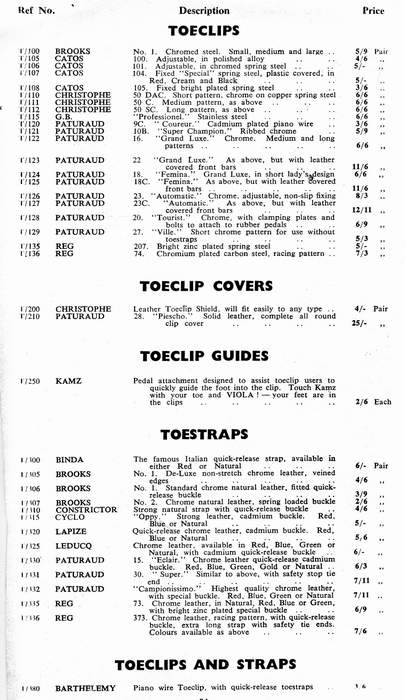
With the increasing popularity of Cyclo Cross in the late 60’s they produced a model designed to stand up to the rigors of this sport, i.e. repeated stamping on and hitting the ground. It was essentially two clips welded together.
The Christophe design was widely copied by Brooks, Cinelli, Campagnolo, ALE (main Italian makers based in Torino), Reg, Galli, Lambert, Lapize (also named after an early Tour rider, Octave Lapize who won in 1910), and Constrictor amongst others. Whether Christophe was actually the originator of this design is unclear.
In the late 30’s Fonteyn imported a version, the Scherens, named after Jef Sherens the Belgium rider who won the World Professional Track Championship from 1932 to 1937 inclusive. Does this make toe clips the most popular component to be named after a rider?
Fig 2 (left) from the 1960 Ron Kitching’s ‘Everything Cycling’ shows the main marques and is a useful guide to relative price. The toeclip covers listed were designed to offer bad weather protection, similar in concept to today’s overshoes. Bernard Hinault the mid 70’s Tour winner lent his name to a plastic pair.
Milremo had clips made in three sizes by Christophe. Ashby, the Birmingham based company who also made saddlebag supports and racks produced a version with a very un-English name ‘Monique’ which was rivetless. The toestrap slot was just formed of bent metal. Another Birmingham based company Catos made Christophe copies in both fixed and adjustable versions and some colour plastic covered.
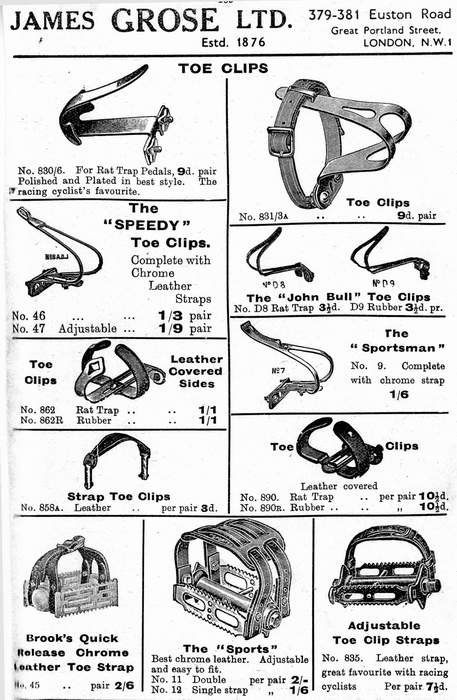
With regard to durability the Christophe is extremely tough. If the clip does fail it is usually at the bend above the pedal fixing after extensive use. The other cause of breakage is the toestrap slot becoming bent, usually by contact with the ground and snapping off.
Toeclips certainly go back to the nineteenth century as the earliest cyclists realised the benefits of some way of securing the foot to the pedal. The Data Book (1) has illustrations from 1911- 12: the clip in its later forms is already evident.
The image from 1937 J A Grose catalogue shows the range at this time. One type that did not survive post WWII was that of the wide strap without a clip.
The rest of this article examines alternatives to the classic Christophe designs:
1. The Piano Wire
Good examples are the Oppy (named after Hubert Opperman, the Australian Tour de France and End to End rider) and Resto, both made by Cyclo from the late 30’s until the end of 50’s. Note the model for use with rubber pedals. Also in this style the Python by Constrictor. As they had a flexible joint they need to be fitted to the rear of the front pedal block/plate.
Paturaud (a French company who only made toeclips and straps) offered a Coureur model available into the mid 60’s, which was in the Christophe shape. Paturard clips were not very durable which explains why not many survived and the high prices they command on eBay.
A Birmingham company, Catos made a range including an adjustable piano wire design Their advertisements are a regular feature in the Cycling Press for over 40 years until the 1980’s. Note the distinctive trade make of the extended ‘C’.
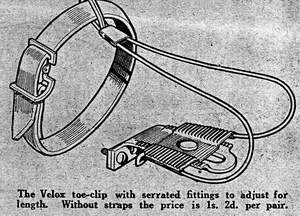
2. The Adjustable
The image left shows an example from the 1931 Cycle Show produced by Ashby. With the aid of serrations the clip could be adjusted to fit the exact shoe size. The one illustrated has an amazing 16 different positions!
Ashby continued to make an adjustable clip until the 1970’s under the name ‘wanderlust’ although the clip was of the Christophe pattern. Paturaud also made a number of clips to this design.
The drawback to this design was that the toeclip could come loose or alternatively rust up solid. Also the elongated toestrap slot meant the toestrap was loose and could twist, making shoe entry difficult.
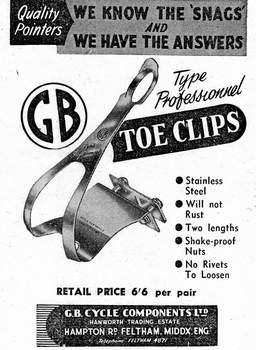
3. Other variants
GB produced a clip, the Professional, with a wider base. Unlike Christophe, the toestrap slot was not riveted, something they stressed in advertising as an advantage. British club cyclists regarded this as far more rust resistant than the Christophe. John Vaughan, a Director of Dawes Cycles mentioned this in one of his highly regarded technical features in the CTC magazine Cycletouring:
“among the few British components which are superior to imported ones are GB toeclips. The reason for this, of course is that they are made from stainless steel. Apart from being virtually unbreakable they are non-rusting … GB for some reasons do not make any short ones so I fit Christophe to my wife’s bike. Within a few months the Christophe are red with rust while the GB are as bright as the day they were purchased. The choice is yours as long as you do not have small feet!” (2)
GB clips were made from 1954 for over 30 years, although latterly only in one size, long.
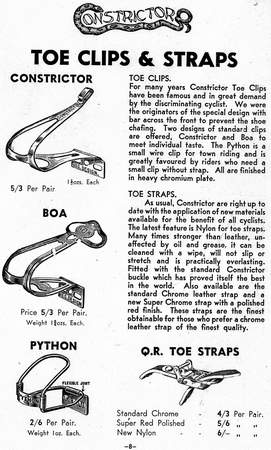
Surely the most fancy design was the Constrictor Boa, which must be the leading contender for toeclip as art (clip art?). Unfortunately they were rather fragile.
The last Constrictor clip (early 60’s) had a gold finish, being made from bronze.
Christophe, Paturaud and others produced half /mini clips which did not need toestraps.
They were marketed as either for the novice or for town riding. Clips were also produced in the 1980’s and 90’s by Christophe and ALE with widely spaced fixings to allow the fitting of pedal reflectors, which have became a legal requirement in many EU countries over the last 20 years.
4. The Last Generation
In the 1980’s Shimano altered the fixing to a three-point triangular horizontal, designed to fit their aerodynamic shaped pedals. The clips were offered in both chromed steel and plastic. The latter of course has the benefit of not rusting nor breaking. However, plastic does have the disadvantage of being more flexible, which means under pressure it will stretch which could lead to overlap with the wheel/mudguard.
Campagnolo produced a similar design for their Victory and Triomph pedals, which were of a horseshoe shape. Christophe produced a two point in line horizontal adjustable fitting for one variant of 1980’s Campagnolo pedals. Earlier in the 1980’s they adopted the Christophe design to include a triangular pointed pedal pick up guide.
The problem with both the above designs is actually finding the right toeclips they are far rarer than the pedals and the standard toeclips do not fit.
The plastic toeclip was adapted for early mountain bikes, being stamp proof and can still be found on lower priced machines. Some were shaped to allow the wearing of heavier shoes/boots. As the plastic is more flexible than metal, a variant was introduced with two upper slots for toestrap entry, so the clip is two pronged. Zefal still make a clip, the model 41 to this design. Since the clipless revolution of the 90’s only MKS are producing a range of traditional pedals and metal toeclips. The later are still based on the Christophe design.
Toeclips can be used with most shoes, although not with many modern ‘trainer type’ cycling shoes designed for clipless, because the front is too high to fit in the toeclip. The great disadvantage of the modern clipless (based originally on the system used for binding ski boots to ski’s) is that you have to use proprietary footwear. So if you just want to nip down to the shops you can’t do it in any old footwear! The two main systems SPD (Shimano Pedalling Dynamics) and the Look (used by Campagnolo) are not interchangeable.
Toeclip Overlap
The dangers of toeclip overlap are well known, a nasty spill. Why then are frames, including some top names, made with this feature? Why should you have to alter your pedalling style to avoid it ? Certainly no fixed wheel bike should in my opinion have any overlap at all.
There are a number of ways of eliminating a small overlap, these include:
1. Using shorter cranks TA made their classic Pro Viz (commonly known as the Cycletouriste) in 2.5mm increments. For example you could substitute 167.5 or 165 for 170mm.
2. Position the clip closer to the outside of the pedal and/ or use wider pedals eg Lyotard 460D.
3. If using mudguards use flatter section ones.
4. Using adjustable toeclips for an exact fit.
5. Using a longer bottom bracket axle.
6. Using lighter tyres and/or no mudguards.
7. If the frame has 27″ wheels use 700c, which gives another 4mm of clearance.
At this point I must confess as someone who rides a 23″ frame and wears size 10½ shoes I am slightly paranoid about this problem. Not wanting to repeat a nasty spill, I always check the front centre distance before buying a frame.
If your clips are too small they can be made longer by using a piece of wood or metal in front of the pedal and longer fixing screws.
Top tip for cleaning up rusty clips is to rub with a wetted piece of tinfoil.
Alloy Clips
Christophe, Cinelli and Milremo were amongst makers to offer an alloy toeclip in the 70’s and 80’s. The attraction was weight saving (about 35g a pair compared to steel). Cinelli’s were made of ergal and were available in silver, black, blue or gold. As I said at the start of this article, these were simply not durable. Some of the more innovative French firms had tried this in the 40’s and realised this. Heavy forward pressure on the shoe could result in the clip shearing off usually above the pedal fixing point.
Whilst researching this article I discovered the toeclip is not dead in the 21st century. Bruce Gordon, an American bespoke frame builder, has produced a half model made from titanium tubing. (Priced at $74) Apart from weight they are very durable and when they get scratched they can be brushed with steel wool to look like new. (3)
REFERENCES
(1) The Data Book: 100 years of innovation in bicycle component and accessory design, Van de Plas Publications p53.
NB p54 has a reprint from 1935 showing Christophe and Lapize clips.
(2) Cycletouring, June 1973, John Vaughan p128 (starting in August 1972 for nearly three year the CTC magazine featured an excellent series of technical articles only ceased by John’s untimely death.)
(3) Vintage Bicycle Quarterly Autumn 2005, Vol 4, No 1 p41 and www.bgcycles.com
Other sources : Holdsworthy Aids, Everything Cycling.
Posted: Tuesday 16th June 2020
This article appears in the following categories.
Upcoming Events
Whether you are looking for a gentle social meet up, or a 100-mile ride browse the community’s upcoming events and plan your next weekend outing.
